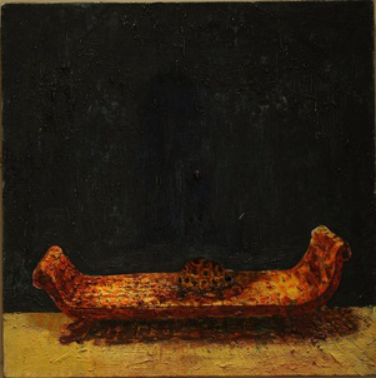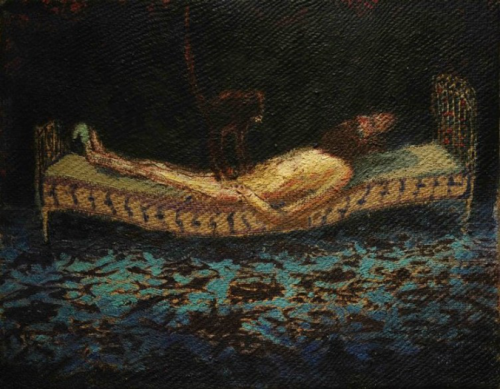An essay by Liza Dimbleby
Andrew Cranston: What to Do After a Death in Scotland, an exhibition at Hamish Morrison Galerie Berlin, November 2013.
An expanded version of this essay has been published in the book Andrew Cranston, Who Is This Who Is Coming? Aye-Aye Books, 2015. PDF of the full text available here
“Dreams are objective facts. They do not answer our expectations and we have not invented them”. (Wilfred Bion)
Each day we perform a precarious saunter岌岌可危的猎人 from sleep to waking and from waking life to sleep. At the threshold门槛 there is always resistance抵抗力; too sudden突然 a transition is a shock震惊. These are different worlds; and yet there is a continual连续的 daily traffic between the landscapes of our sleeping mind and our daily waking encounters遭遇. Images from dreams hover徘徊at the side of consciousness意识 or ride before us as we field the relentless visual triggers 无情视觉触发of everyday life. Likewise the images we have taken in by day, in the street, in pictures or films, insist and reactivate坚持和重新启动 themselves beyond our waking consciousness. The border边境 is porous多孔的 and we cannot build a resistant wall. Instead there is a continuous plunder搜刮; a shape-shifting and rearranging, eluding our designs.形状转换和重新布置,避免了我们的设计

The artist who makes this uneasy translation his work is himself subject to the transient短暂的 and variant变种 truths of what remains unseen. He too must overcome a stubborn倔强 resistance and give himself up to work, as to sleep. A tortoise drawn into its shell on a square patterned chaise longue一个方形图案的躺椅, The Problem with Painting,(↑) reminds us of the slow game of image making, of the importance of surfaces.
The game is a strange complicity一个奇怪同谋 of consciousness and unconscious意识和无意识, distilled蒸馏 through time and through the media of paint, glass and dust, layers of varnish漆. The images that persist坚持 are those that keep returning. Another title, A Narrative Driven by Shape, refers to the way that shapes lead, prior to words or even outline. The humped bedclothes床上用品 of Carl Spizweg’s “Poor Poet” painting resurface as icebergs. A boulder巨石 the painter once climbed recurs溯回 repeatedly, referring to Netherland landscape paintings, to the film Picnic at Hanging Rock, recalling a Beckett stage set, a huge cyst一个巨型囊肿; a form一种形式 that evokes boulder, cyst and anal sphincter in one, with women and parasols hovering above (in the painting 1900). This annus/anus肛门 image might also remind the Beckett conscious viewer not only of the writer’s stagings, but of his persistent problems with cysts, on his neck and memorably in his anus, for which he consulted the psychoanalyst Wilfred Bion, cited above. In other pictures the ovoid shape is a paint lid-ship’s funnel, a head of frizzy spectral hair.

In Hero, a flaccid松弛 figure sits slumped陷落 on top of a massive swollen shape - egg, world or rock. The body is forlorn绝望, middle aged, tattooed across the shoulders the words REAL LIFE. The pathetic cipher可悲的密码 that is our waking life sits just managing to keep on top of this vast excrescent激进的 boulder of paint and dirt and hairs and varnish. Varnish pools, seeps渗漏 and bulges膨胀, catching dust and hair, yellowish smears涂抹; containing its detritus碎屑 like a perverse不正当 amber琥珀, a pustulent cyst脓疱囊肿. This is the stuff from which paintings are made. This brute蛮横 impenetrable不可穿透的 mass is the whole mute无声 indeterminacy不确定性 of everything that remains hidden from us; the inchoate初步 world we hardly fathom捉摸 yet remain bound势必 to. We can only hope to hold our ground保持我们的地位; we are unable to escape it. We suspect it to be more powerful than us. Its half-deciphered半解密 contents remain suspended暂停 in the murky阴沉 resistance of resin树脂.
This stubborn固执 materiality is evident also in the large painting I See a Darkness. The icebergs are themselves glass, shards in a black-oil varnish sea. Icebergs like bedclothes, like death, like separation. In After Fuseli(↓), the slack and warp of sacking on which a mattress is painted yields to the paint as it does to the man painted lying on his bed; the sag of canvas is the sag of the mattress itself. A monkey hovers徘徊.

The shadow of a man, the after-images of Fuseli, Vuillard’s wallpaper, an early French “ambient horror” film still (Jacques Tourneur), dark lit rooms and the memory of end of century intimisme迷恋. After-images of things seen combined with that which surfaces. In this hybrid hinterland腹地 we are trying to look at things usually kept hidden. As for the intimistes, as for Beckett, the lighting is crucial to the staging. It is a night time world, warmly lit. The images that are encouraged to surface are sometimes taboo; sex, death, nightmares and the ultimate questions, not without a sly humour狡猾的幽默.

The wall is a recurring反复出现 image. A wall that divides the imaginary space; a wall or canvas set in space, but also the wall that separates sleep and waking life, never absolutely. A wall that is as much a projection screen投影屏幕 for the shadow lives of each consciousness in the other as it is a true separation分割. Something is always stirring搅拌 on the other side of the wall.
To make and remake the thing; the materials are unpredictable不可预测 but that is crucial关键 in this game of hazard危害 and incitement煽动. The artist translates with wit机智 from a world that is both intimate亲近 and estranged疏远; he lies in wait for the stuff that might surface from the viscosity粘性, from the almost impenetrable不可穿透的. He waits for something that might be recognised. Painting is perhaps the only way to ease缓解 the transition, to confront the wall.
Liza Dimbleby, Glasgow, November 2013
———————————-
what is the WALL?
Is it the wall between dream and ‘our daily waking encounters’?
Cranston’s paintings are acting like a window on the wall, which has similar function as a projection screen
No comments:
Post a Comment